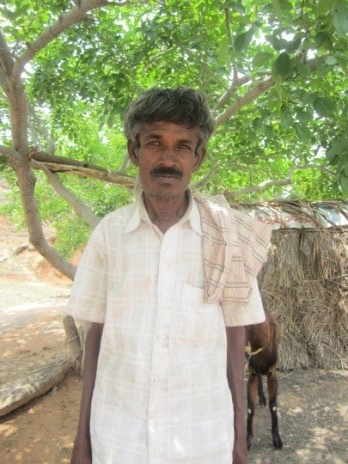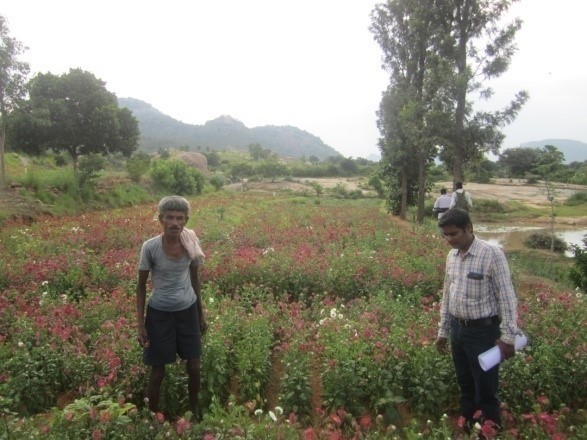
Mr. Venkatappa, S/o D.Nagenahalli, Anupanahalli Post, Kollala Hobli, Koratagere Taluk, Tumkur District – 572140. Mobile: 611968711
Sri.Venkatappa is a marginal farmer of D.Nagenahalli village in Koratagere taluk of Tumakuru district. He is one of the farmers in D.Nagenahalli village who participated in the TDC-NICRA (Technology Demonstration Component – National Initiative on Climate Resilient Agriculture) Project of KVK, Hirehalli. He has 1.75 acre of land (of slightly slope with poor fertile soil). Before intervention, he used to grow one or two crops like Paddy (0.50 acre) and Groundnut (1 acre) or Ragi only during the monsoon in 1.5 acres, leaving 0.25 acre as fallow. Paddy was tried by him, and many of the other farmers in this village, because of the seepage water from upstream and consequent water logging condition. Because of this, he could not take any other crops. The farm income used to be less due to uneven rainfall and restricted crop choice.
The NICRA team from KVK, Hirehalli met him and discussed about the interventions. Gradually suitable interventions were introduced. The land was leveled and made compartments to reduce the soil erosion. A farm pond of dimension 10m x 10m x 2m with water storage capacity of 200 cu m was dugout to harvest the runoff in the year 2011. He started cultivating about three crops per year with the help of farm pond. Later, he brought the remaining 0.25 acre also under cultivation. He tried vegetables and aster flower along with his earlier crops in his farm after the intervention, which was typical example of diversification at farm level. The sole dependency on groundnut during monsoon and paddy in the water logged area was replaced with the diversified cropping system, which is found to be very important as far as livelihood security is concerned. During these years even though monsoon was not good, he still managed to get sufficient yield with the harvest of whatever rain water precipitated. It was possible only due to his 200 cu.m farm pond. However, he used the collected water for irrigation at the critical stages. Given below are the details of additional yield and income gained by the farmer during 2011-12 to 2013-14 due to the additional water supply from the farm pond and the additional crops possible by the interventions.
Table 1. Impact of farm pond on income of the farmer
| Crop | Variety | Area (Acre) | Yield | Gross Cost (Rs.) | Gross Return (Rs.) | Net Return (Rs.) |
| 2010-11 (Before NICRA) | ||||||
| Paddy | Local | 0.5 | 7 q | 6150 | 9570 | 3420 |
| Groundnut | Local | 1.0 | 5.7q | 4492 | 14872 | 10380 |
| TOTAL | 10642 | 24442 | 13800 | |||
| 2011-12 (After NICRA) | ||||||
| Paddy | Local | 0.75 | 14 q | 9100 | 14400 | 5300 |
| Tomato | Lakshmi | 0.25 | 7 tonne | 13700 | 41700 | 28000 |
| Chilli | Local | 0.25 | 1.5 q | 5500 | 25500 | 20000 |
| Coriander | Local | 0.25 | 8 q | 2500 | 18500 | 16000 |
| TOTAL | 30800 | 111130 | 69300 | |||
| 2012-13 | ||||||
| Paddy | Local | 0.75 | 16 q | 9500 | 15500 | 6000 |
| Aster | Local | 0.5 | 14 q | 4500 | 17900 | 13400 |
| Tomato | Local | 0.5 | 5 tonne | 10500 | 21500 | 11000 |
| TOTAL | 29500 | 54900 | 30400 | |||
| 2013-14 | ||||||
| Paddy | Local | 0.75 | 18 q | 10500 | 19500 | 9000 |
| Aster | Local | 0.5 | 16 q | 6000 | 20500 | 14500 |
| Tomato | Lakshmi | 0.5 | 6 q | 12500 | 37500 | 25000 |
| TOTAL | 29000 | 77500 | 48500 | |||
His income increased more than double in these years as shown in the table. The BC ratio was 1:2.3 before the intervention. But it improved to 1:3.6 and 1:2.7 in the years 2011-12 and 2013-14, except for the year 2012-13 (1:1.9)
